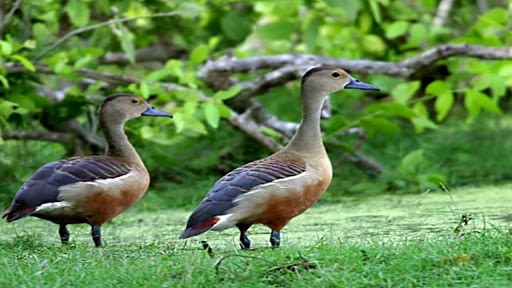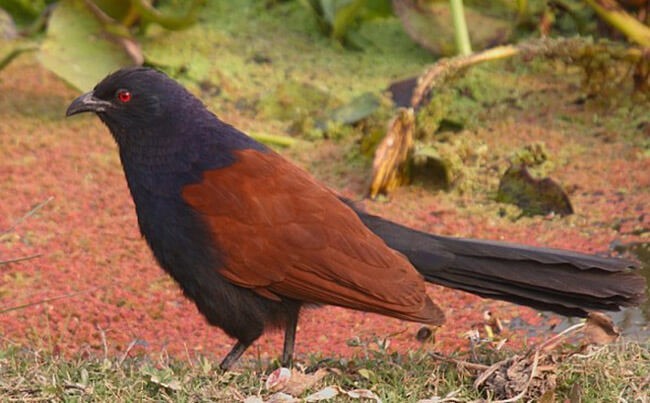*Bắc Kim Thang* -
*Author: Dân ca Nam Bộ (South Folk song)*
*Bắc kim thang cà lang bí rợ*
*băk kim ðaŋ ka laŋ bi rơ*
*Cột qua kèo là kèo qua cột*
*kôt wa keo la keo wa kôt*
*Chú bán dầu qua cầu mà té*
*t͡ɕu ban jau wa kau ma te*
*Chú bán ếch ở lại làm chi*
*t͡ɕu ban ek ơ lai lam t͡ɕi*
*Con le le đánh trống thổi kèn*
*kon le le danʰ dʒôŋ ðôi ken*
*Con bìm bịp thổi tò tí te*
*kon bim bip ðôi to ti te*
*English translation:*
*Bac Kim Thang Ca Lang bi ro*
*Cot qua keo la keo qua cot*
*Crossing the bridge, Uncle selling oil falls down.*
*Uncle selling frogs can’t stand still.*
*Le Le (a kind of animal) play drums, play trumpets.*
*( Con le le - This picture was copied from internet.*
*Source: http://daidoanket.vn/nuoi-chim-le-le-448288.html)*

*Bim Bip (a kind of animal) play “to ti te” “to ti te”*
*( Con bim bip - This picture was copied from internet.*
*Source: https://nilp.vn/cach-ngam-ruou-bim-bip/)*

*The analysis of sentence structures from T^^*
*This is the song I learned since I was a kid. After many years, weirdly, I can sing it without missing any words in the song. Simple content and ear-catching melodies. Strangely, I heard somewhere about its scary content but I’m Vietnamese and I understand the song with its very simple content not scary like that. I believe my thinking is logical, because a folk song for children should be something simple and lovely not something scary or something for adults.*
*1st sentence: “Bắc kim thang cà lang bí rợ”*
*Actually I’m Vietnamese but I really don’t undesrtand this sentence at all and I don’t care. So please don’t worry if you can’t understand too. It’s simple to understand that it’s like hihi hahha balbla balbla hihhi haha in a very funny way with ear catching melody.*
*2nd sentence: “Cột qua kèo là kèo qua cột”*
*Same like the 1st sentence, I really don’t understand the whole sentence at all and I don’t care too. Please don’t worry. Just hihi haha and blabbal balblab in a very funny way with ear catching melody.*
*3rd sentence: “Chú bán dầu qua cầu mà té”*
*Chú bán dầu: Uncle selling oil – a noun phrase – subject*
*Chú: Uncle (noun). Actually it’s just a guy not the singer’s uncle but I want to show the very politeness and close connection between people in rural areas.*
*Bán dầu: selling oil – verb phrase – used as a adject phrase*
*Bán: to sell (verb)*
*Dầu: Oil (noun) helping word to complement to the verb “bán” – to sell.*
*Qua cầu: to cross the bridge – verb phrase*
*Té: to fall down (verb)*
*Mà: a conjunction. But in english to connect two sentences with the same subject, I translated into “crossing the bridge, uncle selling oil falls down” but in Vietnamese, normally we don’t say that, we say “uncle selling oil is crossing the bridge, then fall downs”*
*4th sentence: “Chú bán ếch ở lại làm chi”*
*Chú bán ếch: Uncle selling frogs – noun phrase – subject*
*Chú: Uncle (noun). Actually it’s just a guy not the singer’s uncle but I want to show the very politeness and close connection between people in rural areas.*
*Bán ếch: selling frogs – verb phrase – used as a adjective phrase*
*Bán: to sell (verb)*
*Ếch: Frogs (noun) helping word to complement to the verb “bán” – to sell.*
*Ở lại: to stand still (verb phrase)*
*Làm chi: an exclamation to say how can kind of that.*
*5th sentence: “Con le le đánh trống thổi kèn”*
*Con le le: Noun – subject. A kind of bird.*
*Đánh trống: To play drums (verb phrase)*
*Thổi kèn: to play trumpets (verb phrase)*
*6th sentence: “Con bìm bịp thổi tò tí te tò tí te”*
*Con bìm bịp: Noun – Subject. A kind of bird.*
*Thổi: To play (music) (verb phrase)*
*Tò tí te Tò tí te: Music sound.*